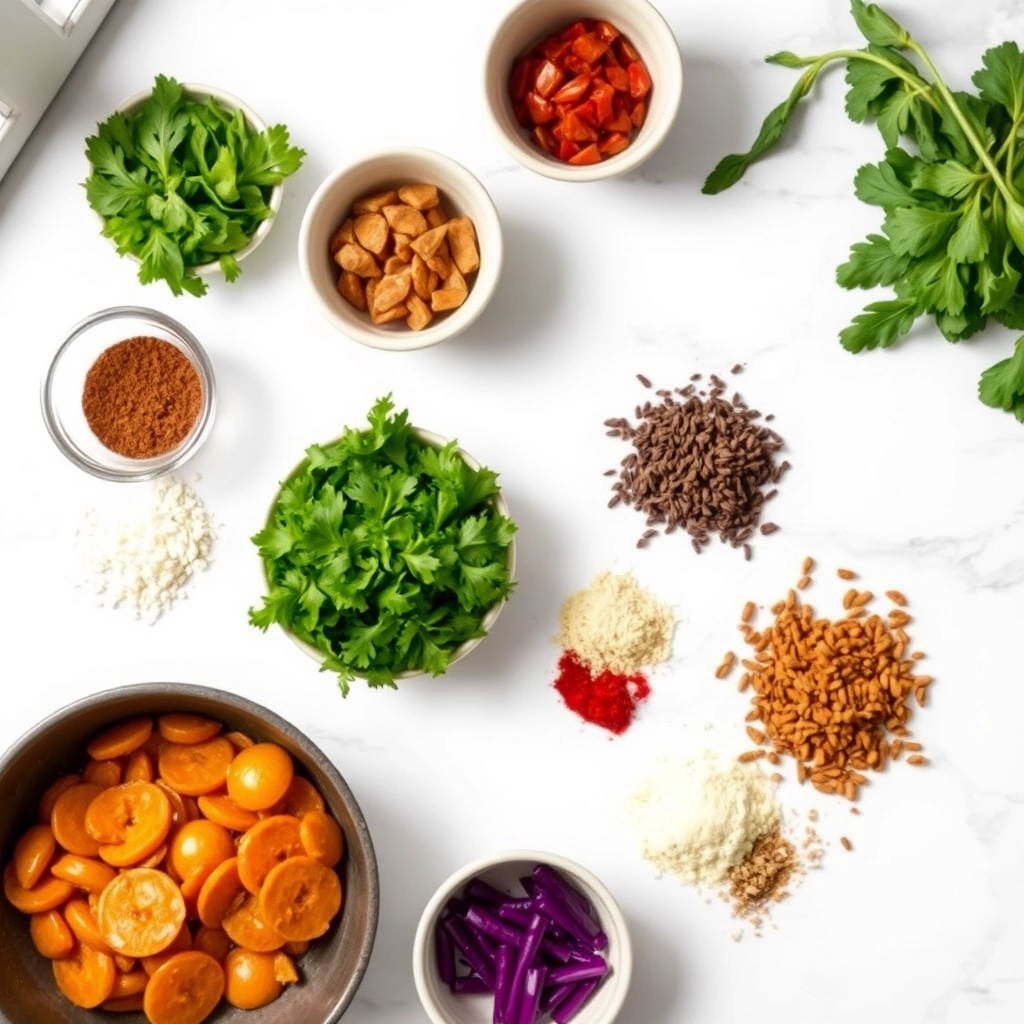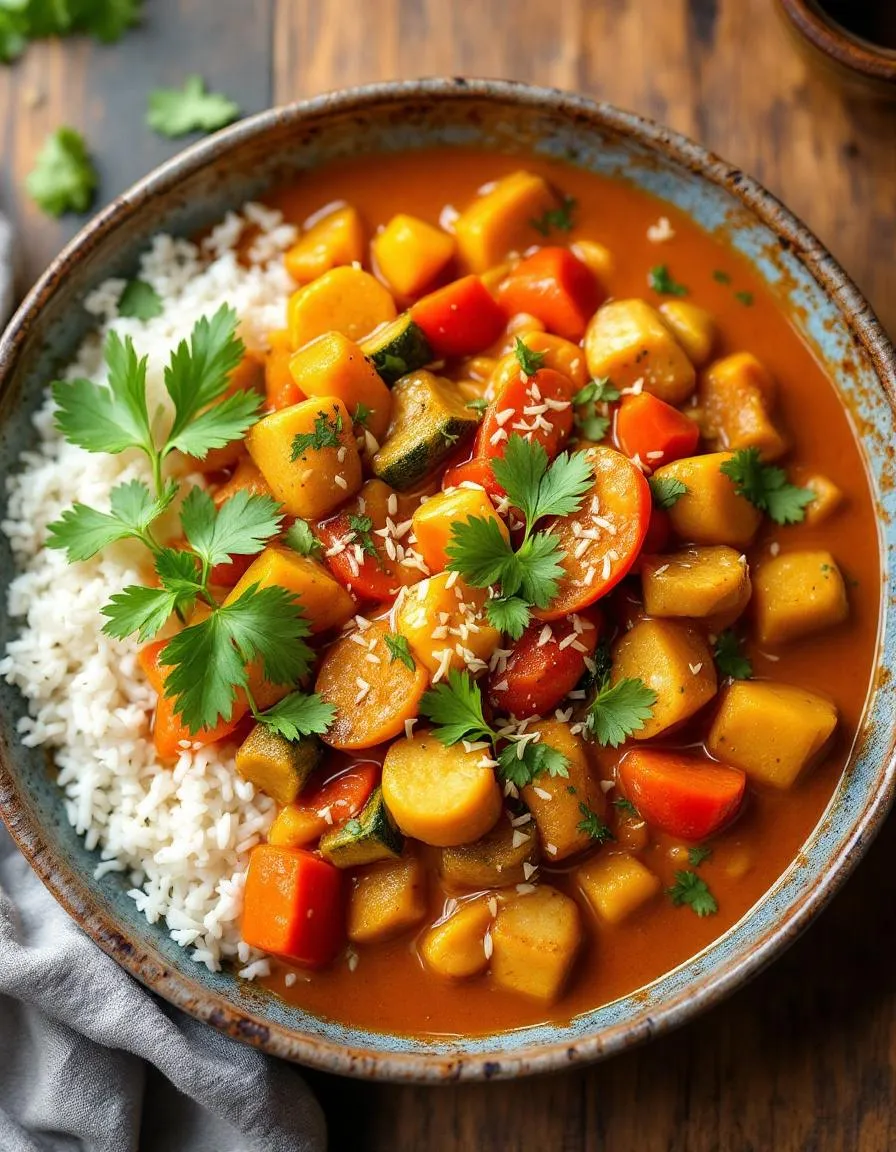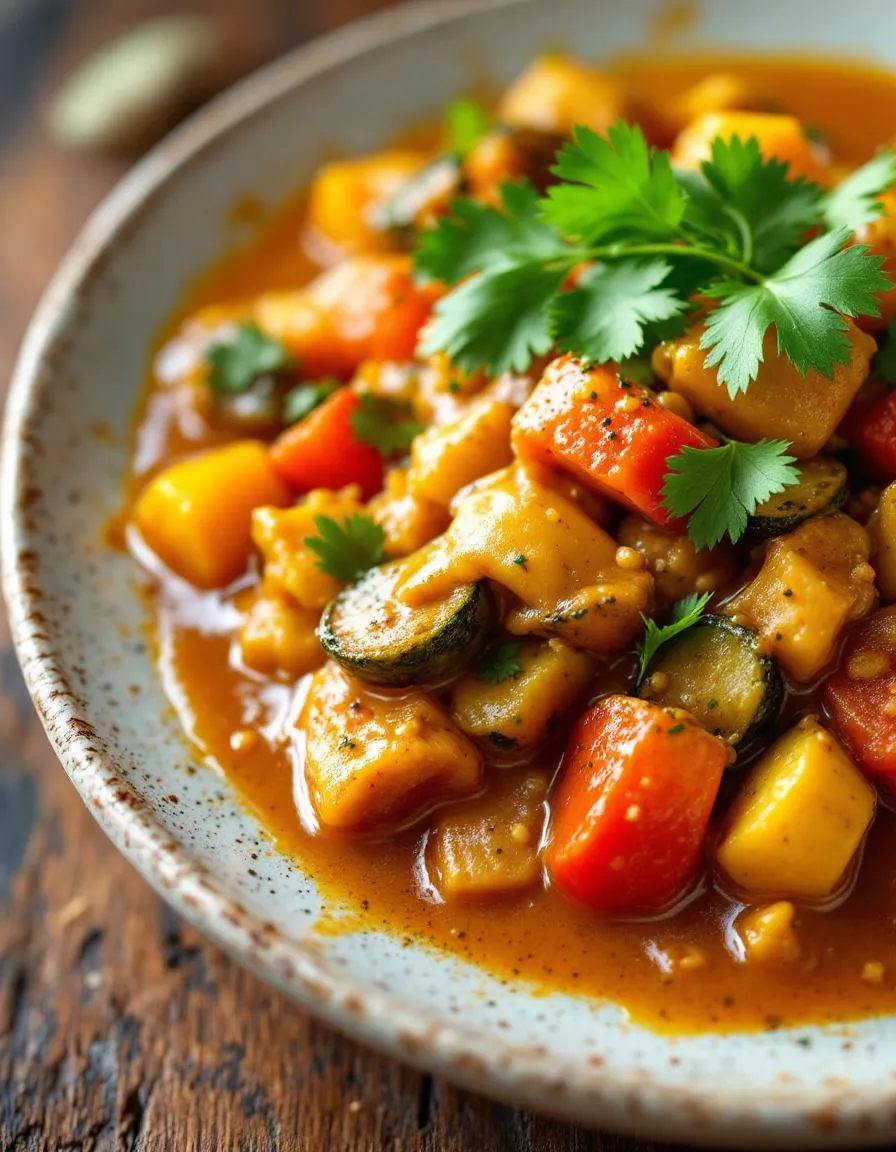Introduction
Hi there! I’m Emily, the heart and soul behind brekcakes.com. From my earliest memories, the kitchen has always been a place of warmth and creativity. It’s where I discovered the magic of turning simple ingredients into extraordinary meals and learned that the best dishes are often made with love as the main ingredient.
There’s something truly special about a dish that brings both comfort and adventure to the table. That’s exactly what Caribbean Vegetable Curry does—it wraps you in vibrant flavors while whisking your taste buds away to sun-soaked islands. Whether you’re craving a hearty plant-based meal or simply want to explore global cuisine, this recipe delivers warmth, nourishment, and a burst of tropical joy. Plus, it’s a fantastic way to use up seasonal veggies, making it as practical as it is delicious.
Caribbean Vegetable Curry is a celebration of bold spices, creamy coconut milk, and fresh produce. Unlike traditional curries, this version leans into the region’s love for allspice, Scotch bonnet peppers, and thyme, creating a uniquely aromatic dish. What makes it stand out? It’s incredibly adaptable. You can toss in whatever vegetables you have on hand, from sweet potatoes to bell peppers, and still achieve a rich, satisfying result. For anyone exploring vegetarian dinners, this curry proves plant-based eating never means sacrificing flavor. It also aligns perfectly with my blog’s mission: approachable recipes that feel like a hug on a plate. If you’re new to Caribbean flavors, don’t worry—this dish welcomes you with open arms, just like the comfort food classics you already adore.
Why I Love This Recipe
Caribbean Vegetable Curry holds a special place in my heart because it reminds me of a trip to Jamaica, where I first tasted the magic of island spices. The way the curry simmered in a roadside café, filling the air with its irresistible aroma, stuck with me long after I returned home. Now, every time I make it, I’m transported back to those lazy beachside evenings. Beyond nostalgia, I love how this dish brings people together—whether it’s a weeknight dinner or a festive gathering, it always sparks conversation and empty plates.
Health and Nutrition
Why it’s good for your body
Caribbean Vegetable Curry packs a powerful nutritional punch while delighting your taste buds. First, it’s loaded with fiber-rich vegetables like sweet potatoes, bell peppers, and spinach, which support digestion and keep you full longer. Additionally, the blend of Caribbean spices, such as turmeric and cumin, offers anti-inflammatory benefits that may help reduce joint pain and boost immunity.
Moreover, Caribbean Vegetable Curry provides a balanced mix of plant-based proteins from ingredients like chickpeas or lentils. These proteins help maintain muscle health without the saturated fats found in meat-based dishes. The coconut milk in the curry also delivers healthy fats, which promote brain function and heart health. Meanwhile, the dish’s vibrant colors signal a high antioxidant content, protecting your cells from damage.
Finally, Caribbean Vegetable Curry naturally fits into many dietary preferences, whether you’re vegetarian, vegan, or simply aiming to eat more whole foods. Its rich flavors mean you won’t miss heavy creams or excessive salt. Instead, you’ll enjoy a meal that nourishes your body and satisfies your cravings.
How it fits in a healthy lifestyle
Caribbean Vegetable Curry effortlessly aligns with a balanced diet, making it a smart choice for health-conscious eaters. If you’re focusing on heart health, the dish’s plant-based ingredients and minimal processed oils help maintain healthy cholesterol levels. For those following gluten-free diets, the curry is naturally compliant, especially when paired with rice or quinoa instead of bread.
Meal preppers will love how Caribbean Vegetable Curry stores well, so you can enjoy it throughout the week without sacrificing nutrition. It also pairs perfectly with other wholesome dishes, like our Healthy Meal Prep Ideas, to keep your eating routine varied and exciting. Plus, if you’re exploring more plant-based options, check out our Vegan Protein Sources to round out your diet with even more nutrient-dense foods.
Whether you’re cooking for one or feeding a family, Caribbean Vegetable Curry fits seamlessly into a lifestyle that prioritizes flavor and wellness. It’s a delicious way to stay on track without feeling restricted.
PrintCaribbean Vegetable Curry
Description
A vibrant and flavorful vegetable curry with Caribbean spices, perfect for a hearty and healthy meal.
Ingredients
For the Crust:
- 2 tbsp coconut oil
- 1 onion, diced
- 3 garlic cloves, minced
- 1 tbsp curry powder
- 1 tsp ground turmeric
- 1 tsp ground cumin
- 1 bell pepper, sliced
- 1 sweet potato, cubed
- 1 cup cauliflower florets
- 1 cup diced carrots
- 1 can (14 oz) coconut milk
- 1 cup vegetable broth
- 1 cup chickpeas, cooked
- Salt and pepper to taste
- Fresh cilantro for garnish
Instructions
1. Prepare the Crust:
- Heat coconut oil in a large pot over medium heat. Add diced onion and sauté until translucent.
- Add minced garlic, curry powder, turmeric, and cumin. Stir for 1-2 minutes until fragrant.
- Add bell pepper, sweet potato, cauliflower, and carrots. Stir to coat the vegetables with the spices.
- Pour in coconut milk and vegetable broth. Bring to a simmer, then reduce heat and cover. Cook for 20-25 minutes until vegetables are tender.
- Stir in chickpeas and season with salt and pepper. Simmer for another 5 minutes.
- Garnish with fresh cilantro before serving.
Notes
You can customize the seasonings to taste.

“`html
How to Prepare This Dish
Steps and time-saving tips
Start by heating a large pot over medium heat and drizzling in a tablespoon of coconut oil. Once the oil shimmers, toss in diced onions, minced garlic, and grated ginger. Stir them for about 2 minutes until fragrant. Next, add chopped bell peppers, carrots, and sweet potatoes to the pot. Let the vegetables soften slightly while you sprinkle in curry powder, turmeric, and a pinch of cayenne for heat. Stir everything together so the spices coat the veggies evenly. Pour in a can of coconut milk and vegetable broth, then bring the mixture to a gentle simmer. Meanwhile, rinse and drain a can of chickpeas before folding them into the pot. Let the Caribbean Vegetable Curry cook uncovered for 15-20 minutes, stirring occasionally, until the sweet potatoes are tender. For a time-saving tip, prep all your veggies the night before and store them in airtight containers. If the curry thickens too much, simply splash in a little extra broth or water. Finish by squeezing fresh lime juice over the top and scattering chopped cilantro for brightness.
Mistakes I’ve made and learned from
Early on, I rushed the sauté step and ended up with undercooked onions that made the Caribbean Vegetable Curry taste harsh. Now I take my time letting them turn golden and sweet. Another blunder? Overcrowding the pot with veggies, which steamed instead of caramelizing. I fixed this by cooking in batches when doubling the recipe. For more on balancing spices, check out my guide to perfect spice blends. And if you’ve ever ended up with mushy vegetables, my veggie texture tips explain how to nail the ideal tenderness every time. Trust me, a little patience and these tweaks make all the difference.
“`

Cultural Connection and Variations
Where this recipe comes from
Caribbean Vegetable Curry tells a vibrant story of migration, spice routes, and cultural fusion. Born from the influence of Indian indentured laborers who brought curry traditions to the Caribbean, this dish evolved with local ingredients like coconut milk, Scotch bonnet peppers, and root vegetables. In Trinidad and Tobago, cooks often add chickpeas or lentils for extra heartiness, while Jamaican versions might feature callaloo or pumpkin for a earthy sweetness. Meanwhile, in Guyana, you’ll find Caribbean Vegetable Curry simmered with a touch of tamarind for tangy depth.
My grandmother’s version, passed down through generations, always included a secret splash of rum for warmth. Across the islands, families debate whether to use green mango for acidity or golden potatoes for creaminess. Some even serve it with a side of fried plantains or roti for soaking up every last bit of sauce. No matter the twist, Caribbean Vegetable Curry remains a celebration of resilience and creativity—a dish that adapts to whatever the land and season offer.
How it fits in today’s cooking
Today, Caribbean Vegetable Curry shines as a plant-powered star, fitting perfectly into meatless Mondays or vegan feasts. Busy cooks love its one-pot simplicity, while meal preppers appreciate how the flavors deepen overnight—just like our favorite make-ahead dishes. During holidays, it often shares the table with jerk chicken or coconut rice, bridging tradition and modern tastes.
Health-conscious tweaks, like swapping coconut milk for light versions or loading up on seasonal veggies, keep it fresh for today’s kitchens. Some even repurpose leftovers into savory curry-stuffed flatbreads. Whether you crave comfort on a rainy day or need a colorful centerpiece for gatherings, Caribbean Vegetable Curry delivers—proving some traditions only get better with time.
Taste and Texture
What makes it delicious
Caribbean Vegetable Curry bursts with vibrant, layered flavors that dance on your tongue. The rich, fragrant coconut milk base wraps around tender sweet potatoes and crisp bell peppers, creating a luscious, creamy texture. Meanwhile, warm spices like turmeric and allspice add earthy depth, while a hint of Scotch bonnet pepper delivers a gentle, lingering heat. Every bite of Caribbean Vegetable Curry feels like a celebration—savory, slightly sweet, and utterly satisfying. The aroma alone, with its mix of fresh thyme and toasted cumin, will make your kitchen smell irresistible.
Boosting the flavor
For an extra flavor kick, try stirring in a spoonful of mango chutney or a squeeze of lime juice just before serving. The tangy sweetness balances the curry’s warmth perfectly. If you love heat, add a pinch of cayenne or top it with quick-pickled onions for crunch. Pair it with fluffy coconut rice or crispy plantains to round out the meal. For more spice inspiration, check out our guide to essential Caribbean spices. Or, if you’re craving a cooling contrast, whip up a batch of creamy avocado dressing to drizzle on top.

Tips for Success
Best practices for results
For the best Caribbean Vegetable Curry, always toast your spices first to unlock their full flavor. Next, simmer the coconut milk gently to prevent it from separating, and stir occasionally for even cooking. Additionally, chop your vegetables uniformly so they cook at the same rate. Finally, taste and adjust the seasoning just before serving, as the flavors develop over time.
Mistakes to avoid
Avoid overcrowding the pan when sautéing vegetables, as this can lead to steaming instead of browning. Instead, cook in batches if needed for better texture. Also, don’t skip blooming the spices—this step is key for a rich, aromatic Caribbean Vegetable Curry. For more on balancing spices, check out our guide to perfect spice blends. Lastly, resist the urge to overcook the vegetables; they should stay slightly crisp. Learn how to master vegetable texture for ideal results every time.
Serving and Pairing Suggestions
How to serve this dish
Caribbean Vegetable Curry shines when you serve it in a vibrant, shallow bowl to showcase its rich colors. For a festive touch, garnish with fresh cilantro, lime wedges, or thinly sliced scallions. Meanwhile, consider pairing it with fluffy coconut rice or warm roti for a complete meal. This dish works beautifully for casual weeknight dinners yet also impresses at potlucks or holiday gatherings. To elevate the presentation, add a side of tropical fruit salsa or avocado slices for contrast.
What goes well with it
A crisp, citrusy mango lassi balances the warmth of Caribbean Vegetable Curry perfectly. Alternatively, try a chilled glass of ginger beer for a refreshing contrast. For sides, this coconut lime rice recipe adds a creamy, tangy note that complements the curry’s spices. If you prefer something lighter, a simple cucumber salad with lime dressing brightens each bite. Finally, don’t forget to explore this Caribbean jerk marinade for a protein-packed pairing option.

Caribbean Vegetable Curry often includes hearty vegetables like potatoes, carrots, bell peppers, and eggplant. Some versions also feature okra, pumpkin, or green beans for added texture and flavor. These veggies absorb the rich curry spices, making the dish vibrant and satisfying.
Caribbean Vegetable Curry can range from mild to spicy, depending on the recipe. Traditional versions often use Scotch bonnet peppers or habaneros for heat, but you can adjust the spice level to taste. The warmth of the curry powder balances the heat, creating a flavorful but not overpowering dish.
Yes! Caribbean Vegetable Curry is naturally vegan when made with coconut milk or vegetable broth as the base. Just ensure your curry powder and other seasonings are plant-based. This dish is a great option for anyone looking for a hearty, meat-free meal packed with Caribbean flavors.
Caribbean Vegetable Curry pairs perfectly with steamed rice, roti, or even quinoa to soak up the flavorful sauce. For an authentic touch, garnish with fresh cilantro or a squeeze of lime. Leftovers taste even better the next day as the spices meld together.

